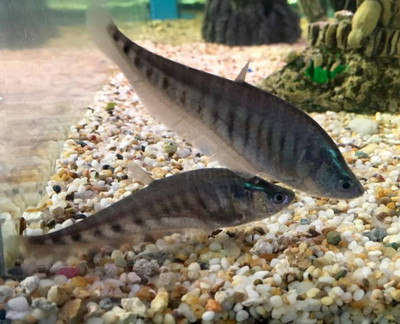Clown Knifefish
Posted by Max Gandara on on 17th Jul 2024
Clown Knifefish: The Majestic Predator of Freshwater Aquariums
The Clown Knifefish (Chitala ornata) is a fascinating and impressive species known for its unique appearance and predatory behavior. These fish are a favorite among experienced aquarists who can provide the space and care they require. In this blog, we'll explore everything you need to know about Clown Knifefish, including their origins, care requirements, behavior, and interesting facts.
What Are Clown Knifefish?
Clown Knifefish are native to the freshwater rivers, lakes, and swamps of Southeast Asia, particularly in Thailand, Cambodia, and Vietnam. They belong to the family Notopteridae and are named for their knife-like body shape and distinctive spots that resemble clown makeup.
Appearance
Clown Knifefish are known for their striking and unique appearance:
- Size: These fish can grow quite large, reaching up to 3 feet (90 cm) in length in the wild, though they typically reach about 2 feet (60 cm) in captivity.
- Coloration: They have a silver-gray body with a series of large, eye-like spots along their sides, which can vary in number and pattern. These spots are most prominent in juveniles and may become less distinct as the fish mature.
- Shape: Their body is elongated and laterally compressed, giving them a knife-like appearance. They have a long, continuous anal fin that runs along the bottom of their body, allowing for graceful and undulating movements.
Tank Requirements
Providing the right environment is crucial for the well-being of Clown Knifefish. Here are the key tank requirements:
Tank Size and Setup
- Tank Size: A minimum tank size of 100 gallons is recommended for a single Clown Knifefish, but larger tanks are preferable due to their size and activity level.
- Substrate and Decorations: Use a soft substrate like sand or fine gravel. Include plenty of hiding spots with large rocks, driftwood, and sturdy plants to mimic their natural habitat and provide shelter.
- Plants: While live plants can be included, choose hardy species that can withstand the fish's size and potential for uprooting. Artificial plants can also be used for decoration without the risk of damage.
Water Conditions
- Temperature: Maintain a stable water temperature between 75-82°F (24-28°C).
- pH Level: Clown Knifefish prefer slightly acidic to neutral water, with a pH range of 6.5-7.5.
- Hardness: They thrive in soft to moderately hard water, with a general hardness (GH) of 4-12 dGH.
Filtration and Maintenance
- Filtration: Use a powerful filtration system to keep the water clean and well-oxygenated. Clown Knifefish produce a significant amount of waste, so efficient filtration and regular maintenance are crucial.
- Water Changes: Perform regular water changes (20-30% weekly) to maintain optimal water quality.
Diet
Clown Knifefish are carnivorous and require a high-protein diet to stay healthy and vibrant:
- Live and Frozen Foods: They prefer live foods such as small fish, shrimp, and worms. Frozen foods like bloodworms, brine shrimp, and krill can also be offered.
- Pellets: High-quality carnivorous fish pellets can be used to supplement their diet, though it may take time for them to accept non-live food.
- Feeding: Feed them once or twice a day, providing only as much food as they can consume within a few minutes to prevent overfeeding and water quality issues.
Behavior and Compatibility
Clown Knifefish are known for their predatory behavior and unique swimming style. They are generally peaceful towards similar-sized tank mates but may prey on smaller fish:
- Tank Mates: Suitable tank mates include other large, non-aggressive fish such as Oscar fish, Arowanas, and large catfish.
- Avoid: Avoid housing them with small fish that can be seen as prey or highly aggressive species that may harass them.
Breeding Clown Knifefish
Breeding Clown Knifefish in captivity is challenging due to their size and specific requirements:
- Tank Setup: Provide a large breeding tank with plenty of hiding spots and a soft substrate for egg laying.
- Water Conditions: Maintain optimal water quality and stable parameters to encourage breeding behavior.
- Diet: Feed the breeding pair a nutritious and varied diet to ensure their health and readiness to spawn.
Females will lay eggs on flat surfaces, and the male will guard them until they hatch. Raising the fry can be difficult due to their size and dietary needs.
Interesting Facts
- Nocturnal Behavior: Clown Knifefish are primarily nocturnal and are most active during the night. Provide dim lighting and plenty of hiding spots to accommodate their natural behavior.
- Electric Field: Like other members of the Notopteridae family, Clown Knifefish have an electric organ that helps them navigate and locate prey in murky waters.
- Longevity: With proper care, Clown Knifefish can live for up to 10 years or more in captivity.
Clown Knifefish are a captivating and rewarding species for experienced aquarists who can provide the space and care they require. Their unique appearance, graceful movements, and intriguing behavior make them a standout addition to any large freshwater aquarium. By ensuring the right environment, diet, and tank mates, you can enjoy the presence of these majestic fish for many years.

